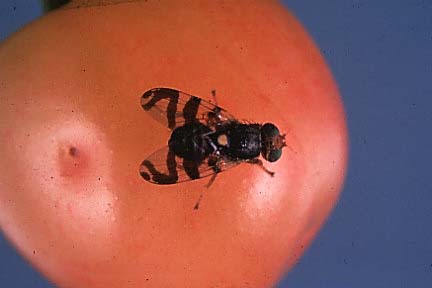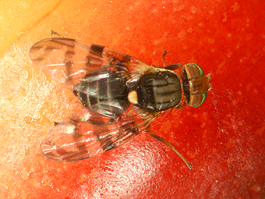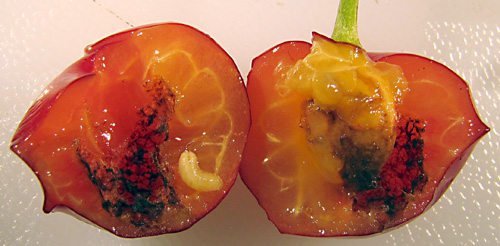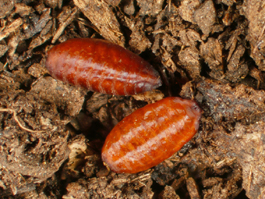
Cherry fruit fly
| Primefact number | Edition | Published | Author |
|---|---|---|---|
| 1294 | First | Apr 2013 | Plant Biosecurity and Product Integrity |




Black cherry fruit fly (Rhagoletis fausta) and western cherry fruit fly (Rhagoletis indifferens) are exotic plant pests. These two cherry fruit flies are a serious threat to Australia’s cherry industry.
Black cherry fruit fly and western cherry fruit fly differ in the pattern in their wings and the colour of their abdomens. They are both the size of a small house fly.
Notifiable status
Black cherry fruit fly (Rhagoletis fausta) and western cherry fruit fly (Rhagoletis indifferens) are not notifiable plant pests in NSW.
However, if you suspect black cherry fruit fly or western cherry fruit fly:
- Call the Exotic Plant Pest Hotline 1800 084 881
- Email biosecurity@dpi.nsw.gov.au with a clear photo and your contact details
A full list of notifiable plant pests and diseases can be found in Schedule 2 of the NSW Biosecurity Act 2015.
Damage
Young fruit is damaged by adult cherry fruit fly females laying eggs.
Attacked fruit will be pitted with ovipoisition punctures called ‘sting marks’ which may become discoloured when secondary pathogens enter.
Larvae feed on the cherry flesh near the stone and make the fruit unmarketable.
Description
Adults
The black cherry fruit fly adult has an all black abdomen. Fully grown flies are 4.5 mm in length (Figure 1).
The western cherry fruit fly adult has a black abdomen with white bands. Fully grown flies are 5.0 mm in length (Figure 2).
Both black and western cherry fruit flies have black bodies with tinges of yellow on the head and striped margins on the thorax.
Adults have a creamy white dot near the centre of the back.
The wings are marked with blackish bands. The black bands on the wings are used to distinguish cherry fruit fly species.
Immature stages
The eggs of both black and western cherry fruit fly are creamy white in colour, about 0.6 mm long and slightly curved.
The larvae (maggots) of both black and western cherry fruit flies are creamy white in colour, with no distinct head and reach 4–5 mm in length when mature (Figure 3).
The pupae of both black and western cherry fruit flies are brown in colour. The pupae are an elongated oval shape 4-5 mm in length and look like grains of wheat (Figure 4).
Lifecycle
Cherry fruit flies overwinter as pupae in the soil. Emergence occurs in late spring. Black cherry fruit fly emerges one to two weeks before western cherry fruit fly.
Once emerged cherry fruit flies return to cherry host trees where they mate. The female cherry fruit fly lays eggs singly in cherry fruit. Larva feed for one to two weeks around the cherry seed before cutting a new exit hole and dropping to the ground to pupate.
Although cherry fruit flies normally have only one generation each year, 3-4% can have a second generation in late summer. A similar proportion of flies can overwinter for two years.
Host range
Black and western cherry fruit fly will attack all varieties of cultivated and wild cherry.
Distribution
Black and western cherry fruit flies are endemic to North America.
Spread
Local spread of cherry fruit flies occurs from adults flying to new food sources. Cherry fruit flies are not strong fliers and flight distance is normally 50 m to 100 m.
International spread could occur through movement of host fruit infested with larvae.
Actions to minimise risks
Put in place biosecurity best practice actions to prevent entry, establishment and spread of pests and diseases:
- practice “Come clean, Go clean”
- ensure all staff and visitors are instructed in and adhere to your business management hygiene requirements
- source propagation material of a known high health status from reputable suppliers
- monitor your crop regularly
- keep records

